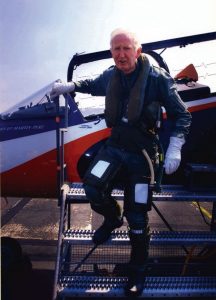It is with great sadness that we record the passing of HAA founder member Duncan Simpson OBE CEng FIMechE FRAeS.
Duncan Simpson’s aviation career began when he won a place at the de Havilland Aeronautical Technical School. Progresing from the training workshops into the Experimental Department and his work included the DH108, the Ghost Vampire and the late developments of the Mosquito and Hornet. Completing the four-year Aircraft Design Course, Duncan became an Associate Fellow of the Royal Aeronautical Society, and won the prize for the best final year apprentice. This provided an excellent grounding for his career as Test Pilot.
At the end of his apprenticeship he joined the Royal Air Force and learned to fly on the Prentice, Harvard and Meteor before beginning a tour on 222 Sqn flying the Meteor 8. After two years, his considerable flying skills were recognised and he was able to persuade the system to post him to the Day Fighter Development Squadron. The squadron was involved in the introduction of the new transonic fighters into the RAF in the early Fifties and operated Sabres, Swifts, Venoms and Hunters; Duncan presciently chose the Hunter to specialise on. In 1954, Neville Duke – then Chief Test Pilot at Hawkers – said he urgently needed him as a Hunter test pilot and so Duncan left the RAF and began his long association with Hawker aircraft.
Duncan was initially engaged on a busy schedule of production test flying this thriving aircraft but gradually became more involved in development work over the years and made a significant contribution to the enormous success of the Hunter. The advent of the revolutionary VSTOL research aircraft added a whole new dimension to Duncan’s test flying. He was the third pilot to fly the P1127 and, when it became the Kestrel, he trained the nine multinational pilots for the evaluation Squadron. He conducted extensive experimental flying on this new aircraft to develop it into the Harrier and was then fundamental to the successful introduction of this remarkable aircraft into the RAF and its adoption by the USMC.
In 1970, Duncan was appointed Hawker’s Chief Test Pilot and, in addition to the considerable ongoing development of the Harrier, he saw the Hawk through from the drawing board to conducting the first flight in 1974. He demonstrated the Hawk at Farnborough just 10 days later and delivered the first Hawk to the RAF in 1976, where it has been in use, as a trainer and by the Red Arrows, for over 36 years. Duncan was made a Fellow of the Red Arrows – prestigious recognition as ‘Godfather’ of the Hawk. His contribution to industry continued after he finished test flying in 1978 when, for the next 15 years, he was the Deputy Director of the SBAC. During this time, he was responsible for all exhibitions, including the world renowned Farnborough Air Show.
Upon retirement Duncan remained extensively involved in aviation, displaying (and helping to preserve) vintage aircraft such as the Lysander, Sea Fury, Hart and Hurricane PZ865 the “Last of the Many”. He was a founder member of the Historic Aircraft Association and was heavily involved in setting its principals and objectives in the beginning. Duncan contributed to the establishment of the display pilot register and display authorisation system eventually adopted by the CAA. He was variously Chairman and a Vice President of the HAA and offered advice and guidance on a range of issues affecting historic aircraft ownership, restoration and display flying. Duncan continued to actively support the HAA until quite recently when ill-health slowed him down.
Current HAA Chairman Wally Epton says of Duncan “I first met Duncan when he handed over Hurricane PZ865 to us in the BBMF at Coltishall in 1972. Years later we met again and I was privileged to follow in his footsteps as a Master of the Guild of Air Pilots and Air Navigators – now the Honourable Company of Air Pilots. Duncan always wanted to know what was happening and quizzed me periodically on HAA Council matters. He was particularly enthusiastic about the HAA pursuing delegated authority from the CAA for administration and oversight since this is what he and his colleagues had hoped to achieve in 1979. Duncan’s wisdom, knowledge and experience have been of great value to me personally over the past 45 years and I feel that it is important to continue the work he began.”
Duncan Simpson’s honours include: the Queen’s Commendation for Valuable Service in the Air; the OBE; the Honourable Company of Air Pilots’s Derry and Richards Medal and the Award of Honour; the Air League Founders Medal and the Royal Aeronautical Society’s Alston Medal.
Duncan was held in high regard by his peers and his wise counsel will be greatly missed.


